Best Stemma QT, Grove Add-Ons for Raspberry Pi and Arduino 2024
Solderless components and kits to build your next project
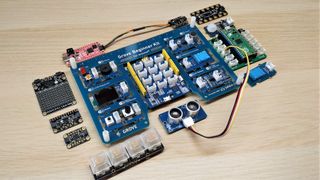
Whether you’re using a Raspberry Pi, Pico, Arduino or ESP32, there is always a great selection of add ons and accessories for your chosen board. If you want to attach sensors, motors, switches and lights to your microcontroller with the minimum of hassle, consider getting components that connect via the Stemma QT (aka Qwiic, QW / ST or Maker Port) or Grove standards.
If your microcontroller / Single Board Computer (SBC) has a connector for one of these standards, you can easily connect to add-ons, with no soldering required. And if your board doesn’t support one of these connections out of the box, an add-on / HAT is available to provide the connectivity. You can even connect them directly to the microcontroller pins with some wires and breadboard, just don't forget the pull-up resistors.
These connections make it easy for learners and children to build electronic projects. Take for example Cytron's Edu Pico which uses Grove connectors for easy connections. By allowing the maker to focus on the code, and not the wiring, they can build their confidence and learn how circuits work before moving on to breadboarding circuits. Right now we're testing another Cytron RP2040 powered board which offers Grove, Stemma QT and traditional GPIO pins in an Arduino Uno form factor. We'll have the full review up in the next couple of weeks.
What Are Stemma QT, Qwiic and Grove?
Why you can trust Tom's Hardware
Stemma QT is from Adafruit and it shrinks the original Stemma interface, used on boards such as the PyPortal, for use with smaller boards or when multiple connections are needed. Stemma QT, is for I2C components which use four pins for communication. StemmaQT is known by other names: Qwiic by SparkFun, Qw/ST from Pimoroni and Maker Port by Cytron. Boards from each range are compatible with each other. The latest Arduino Uno R4 Wi-Fi board also features a Stemma QT port.
Grove connections are a four pin connection favored by Seeed Studio. The connections can be digital, analog, PWM, or I2C.
Connector Comparison
| Device | Connector | Voltage / Logic | Protocols |
|---|---|---|---|
| Stemma | JST PH 3 / 4 Pin 2.0mm pin pitch | 3-5V DC | 4 Pin I2C, 3 Pin Analog / Digital / PWM |
| Stemma QT | JST SH 4 pin 1.0mm pin pitch | 3-5V DC | I2C |
| Qwiic | JST SH 4 pin 1.0mm pin pitch | 3V DC | I2C |
| Qw/ST | JST SH 4 pin 1.0mm pin pitch | 3V DC | I2C |
| Grove | Proprietary 4 pin 2.0mm pin pitch, Compatible with Stemma I2C only | 3-5V DC | 4 Pin I2C / Analog / Digital / PWM |
Stemma QT / Grove components can be used interchangeably thanks to a low cost adapter. when using Stemma QT with Grove, ensure that the Grove connection is for I2C.
But which of these components are the best? The components that will open up a world of cool projects and spark creative ideas? To help you choose, we’ve listed the best Stemma QT and Grove components that we have personally used in projects, for work and pleasure.
Best Stemma QT / Qwiic Components
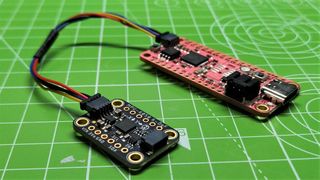
1. Adafruit MPU 6050 6-DOF Sensor
Our expert review:
Specifications
Reasons to buy
Reasons to avoid
$13 is not a lot of money for a sensor of this quality. The MPU6050 can measure acceleration focus, detect which orientation it is in (using the Earth’s gravity) and give us a temperature reading, all from one tiny board.
The board is nothing without software and Adafruit has really stepped up to the plate. CircuitPython support is robust, yet simple. Dropping the correct library file onto our Feather RP2040 and running a quick test script and we had the acceleration forces and positional data in just a few seconds.
The MPU6050 is made for projects that require balance or precise knowledge of the forces acting against it. The small size and ease of use really sell this board for a multitude of projects. Think robotics, such as balance bots and rocketry where even a few degrees out of the norm can mean failure. When you need this type of data, this is the board to reach for.
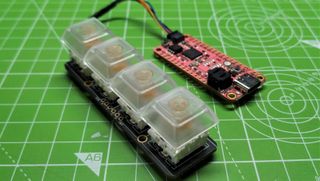
2. Adafruit NeoKey 1x4
Our expert review:
Specifications
Reasons to buy
Reasons to avoid
The NeoKey brings four extra keys to any project. The Stemma QT connector means we can easily connect the keys to many microcontrollers and use them to simulate keypresses in many operating systems.
Designed to work with many different types of mechanical key switches, NeoKey uses a friction fit to hold the switch in place, that means we can easily swap switches based on our preference. On the top side of the PCB are NeoPixels (WS2812) for each key, ready to light up your keypresses.
The beauty of this board is the simplicity. No soldering, easy to build and, thanks to CircuitPython, it is easy to add your own personal shortcut keys for your setup.
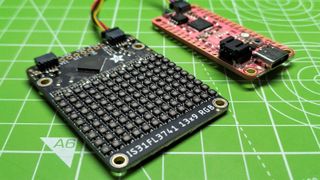
3. Adafruit IS31FL3741 13x9 RGB Matrix
Our expert review:
Specifications
Reasons to buy
Reasons to avoid
RGB LEDs are the candy that makers love and the pinnacle of the technology are NeoPixels but they are not the only delicious beads of light Adafruit’s IS31FL3741 RGB Matrix has a series of RGB LEDs controlled from a single chip, the IS31FL3741.
The 13 x 9 LED matrix has beautiful, saturated colors that leap from the board. The extra Stemma QT connector means we can connect another compatible device and then use the LED matrix as a visual means to output the data. Connect a temperature sensor and set the LEDs to turn different shades of blue as the room gets colder.
Using this board isn’t as easy as NeoPixels or DotStar but the CircuitPython library offers an easy to use means to make the LEDs any color that you wish, and to scroll text across the matrix.
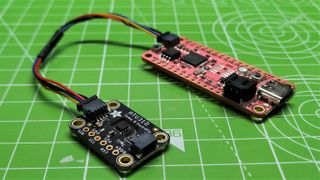
4. Adafruit HTU31D Temperature and Humidity Sensor
Our expert review:
Specifications
Reasons to buy
Reasons to avoid
Hobby temperature sensors run the full spectrum of price and reliability. You can buy cheap and doubt the values, or spend big and get reliable data. But what if we could compromise and get the best of both worlds? Well the HTU31D is just that.
The HTU31D has great accuracy, as long as we keep inside the temperature range. Should we stray outside the range, then things become a little unreliable but 70 degrees Celsius is plenty for most hobbyists. The onboard heater means that condensation can be eliminated, just factor that into your readings.
The supporting CiruitPython library makes incredibly short work of using the board. The library abstracts away the complexities and returns the data with minimal fuss. If this sensor were available in a waterproof package, then it would dethrone the DS18B20 as our favorite temperature sensor.
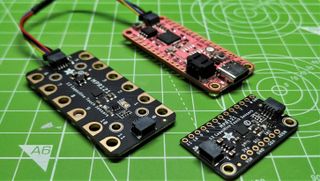
5. Adafruit MPR121 Capacitive Touch Sensor
Our expert review:
Specifications
Reasons to buy
Reasons to avoid
Capacitive input is all around us. Our smartphones, tablets, microwave ovens all have it, so why can’t our Raspberry Pi or Arduino? Well, you can! The MPR121 breakout board offers 12 capacitive touch inputs. Of the two board models we can have either header pin breakouts, or croc / alligator clips. No matter your choice, all you need to do is connect the board to a range of conductive objects (foil, metals, fruit) and then use them as inputs.
The supporting CircuitPython library is exceptionally easy to use, making the process as simple as possible. No, seriously you will have a fruit piano within a few minutes! The MPR121 is a fun board, it quickly engages learners and it can be expanded upon to create a serious input for
Best Grove Components
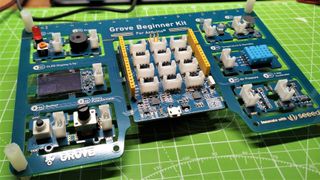
1. Seeed Studio Grove Beginner Kit
Our expert review:
Specifications
Reasons to buy
Reasons to avoid
Getting started with Grove connectors is easy, but this kit makes it even easier. Coming as a pre-connected PCB, Seeed’s Grove Beginner Kit affords us massive scope for invention. The Grove components are already connected to the central Arduino Uno compatible thanks to some clever traces. This means we don’t need to break the components from the sprue to get started. When I tested it for our Seeed Studio Grove Beginner Kit review, we found that programming the Arduino Uno compatible is easy, thanks to a number of software libraries and helpful documentation.
The components can be broken free of the sprue and used in custom projects. Raspberry Pi users can take advantage of the components with a HAT for their board.
If you’re just starting your Grove obsession, then this is the kit to buy. There is an Arduino version, also made by Seeed. That kit brings a real Arduino Uno and a Grove breakout. But the sensors are exactly the same. Save your cash and buy this instead.
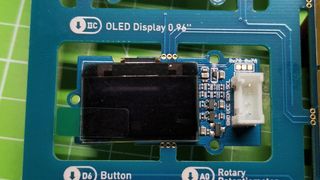
2. OLED Display
Our expert review:
Specifications
Reasons to buy
Reasons to avoid
Organic Light Emitting Diode (OLED) screens offer high contrast, monochrome text and basic images on a tiny screen. This 0.96 inch screen may not be the largest screen, but we can easily use it to display data. If you want to show the temperature, light levels or distance from a sensor, then this screen is the one.
Via the Grove connector, this display uses the I2C communication protocol to send data from your chosen microcontroller (or single board computer). I2C may be a little trickier to use that standard digital IO pins, but the helpful software libraries will abstract the complexities.

3. Ultrasonic Distance Sensor
Our expert review:
Specifications
Reasons to buy
Reasons to avoid
Ultrasonic sensors, such as the HC-SR04 series, are commonplace in the world of robotics, and for good reason. These sensors are cheap, easy to use and fairly reliable.
An ultrasonic sensor with a Grove connector is the ideal means to introduce this sensor to a new learner. The sensor will accept 3V and 5V logic levels, meaning it can be used with the Raspberry Pi and Arduino boards. Other models required a voltage / potential divider to drop the required 5V down to 3V (unless you purchase the HC-SR04+ or HC-SR04P models). The sensor has a range between 2 and 350 cm. In our tests we noted that distant readings became slightly unreliable unless the sensor and target were stationary. Short distances were fine, and a robot running around the carpet was able to dodge obstacles in its path.
The hardware is easy to use thanks to an excellent library for your Arduino which abstracts the complexities away. Raspberry Pi users will get the best performance from GPIO Zero, which has an abstracted module that can easily measure distances.
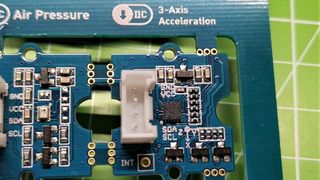
4. 3-Axis Digital Accelerometer
Our expert review:
Specifications
Reasons to buy
Reasons to avoid
Three-axis accelerometers measure forces along the X, Y and Z axes, in the case of this LIS3DHTR based board it can measure up to 16 Gs of force. Why is this useful? If you are out riding your bike, racing or launching model rockets, this tiny board can detect the forces upon you. A little code and this data can be logged to an SD card and used to determine the most extreme parts of your hobby.
The Grove connector is used to connect the sensor using I2C to the board, and then the software handles reading the data. On the wiki page for this sensor there is a basic example of reading the sensor with abstracted code libraries for Arduino users. Raspberry Pi and Python users can use the wiki’s example code, or you can use a CircuitPython library to make it easier to use.
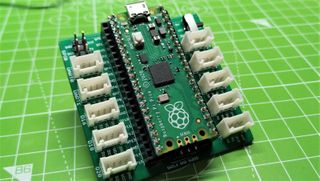
5. Seeed Grove Shield for Raspberry Pi Pico
Our expert review:
Specifications
Reasons to buy
Reasons to avoid
The Raspberry Pi Pico is a great $4 microcontroller, and with this shield we can easily use our collection of Grove components. The Pico is securely held in the center of the board with a series of white Grove connectors surrounding it. These connectors are connected to specific GPIO pins, a limitation that is necessary given the small size of the shield.
The shield works with any Pico compatible programming language, all it really does is provide simpler access to the GPIO. In our review we really liked how easy it was to use, and how it tidied up our mess of wires.
The low cost and easy use make this board the ideal choice for using Grove components with your Raspberry Pi Pico.
MORE: Best RP2040 Boards
MORE: Best Raspberry Pi Projects
MORE: Raspberry Pi: How to Get Started
Stay On the Cutting Edge: Get the Tom's Hardware Newsletter
Get Tom's Hardware's best news and in-depth reviews, straight to your inbox.
Les Pounder is an associate editor at Tom's Hardware. He is a creative technologist and for seven years has created projects to educate and inspire minds both young and old. He has worked with the Raspberry Pi Foundation to write and deliver their teacher training program "Picademy".
